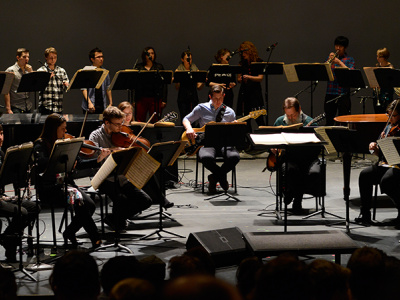What does a Nonprofit Artist do?
While it's often said that simply creating art makes the world a better place, some—like nonprofit artists—desire a more direct approach. These professional musicians, dancers, writers, and theater artists use arts performance and education as tools to spread social justice messages, raise money for important causes, cultivate empathy and understanding in conflict areas, and introduce disenfranchised populations to the transformative power of art in non-traditional settings like hospitals, prisons, rehabilitation centers, community centers, and homeless shelters. They not only work with and for arts-based nonprofit organizations, but also frequently create and helm them.
Arts-based nonprofits have widely varying goals and methods, and nonprofit artists come from an equally broad range of backgrounds. Some are teaching artists who educate marginalized groups, while others are music, dance, or drama therapists who work with clients who could not otherwise afford their services. Similarly, some nonprofit artists are professional performers—actors, dancers, and musicians—who put on shows for audiences who wouldn't have access to high-level performing arts otherwise, or organize and produce concerts and performances to raise money for specific causes. There are also music librarians and musicologists who work with museums, schools, and research institutes to improve cultural conservation, education, and our understanding of the arts.
At a Glance
Nonprofit artists come from a wealth of professional backgrounds, including performance, education, cultural preservation, and arts therapy. Some contribute their efforts to an existing nonprofit, while others found their own organization to tackle a specific problem that they see going unaddressed. While employees can advance within their organization by taking on increased responsibilities, leaders of nonprofit organizations generally aim to expand or solidify their organization's operations, usually by acquiring increased funding from grants and donors. With their combined focus on performance, education, and management, nonprofit artists might be well positioned to direct arts-education programs later in their careers.
Nonprofit artists might be founders and leaders of their own nonprofit groups, outside artists who partner with an existing nonprofit to deliver a performance or teach a class, or employees who are hired in a part-time or entry-level capacity. Artists who are interested in working with nonprofits are advised to check out nonprofit-specific job sites like Idealist(Opens in a new window), while those who wish to create their own nonprofits will need to apply for funding from grants and foundations.
- Live performance
- Arts education
- Grant writing
- Social justice
- Public speaking
- Nonprofit management
- Written and verbal communication
- Leadership
Nonprofit artists are educators and organizers who believe passionately in doing good through and for the arts. They are benefitted by excellent public speaking, organization, and communication skills, as well as flexibility, humility, and dedication. The best nonprofit artists are also fantastic team players, understanding that working with or for a nonprofit organization sometimes means performing in a setting that's less than ideal, dealing with a lack of resources, or taking on duties that are outside of one's job description.
In the nonprofit world, there's often an expectation that team members will fulfill multiple roles, provide and acquire a number of skills to serve the organization, or even put in as much time as is needed without guarantee of overtime payment. Performers may double as costumers, administrators may run the sound board during performances, and executives may find themselves working in the office late at night, applying for grants and taking care of payroll. Still, it's work done in service of a greater cause, which is why nonprofit employees are often among the most gratified and fulfilled in the world. Those who work for more established arts nonprofits may perform more distinct roles and be grouped into specific departments.











